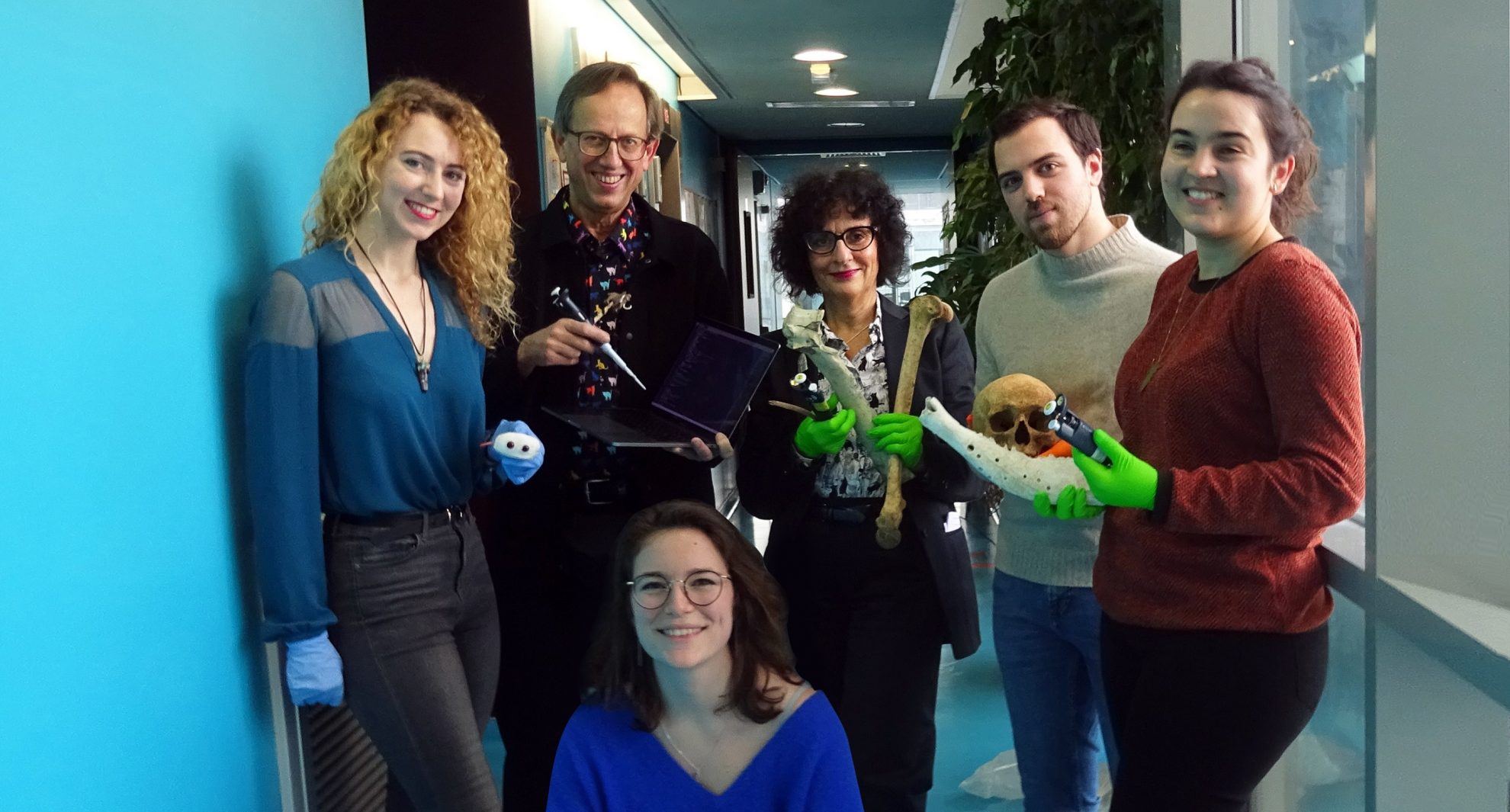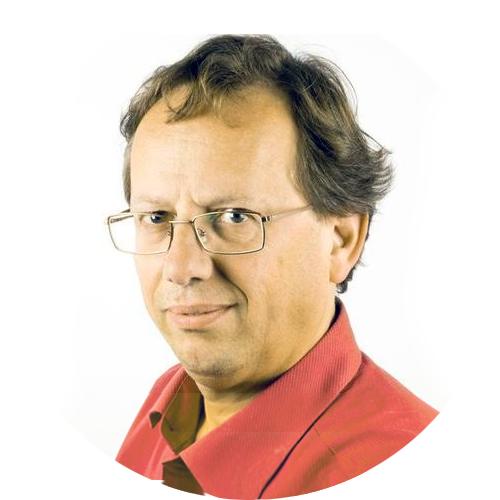The “Epigenomics and Paleogenomics” group of the Institut Jacques Monod, Université de Paris and French National Centre for Scientific Research (CNRS) is interested in the evolution of genomes, species and populations of animals, including humans. Their approach is the study of DNA preserved in archaeological and paleontological bone since these are the direct witnesses of evolution. They developed both decontamination as well as library construction methods to increase the reliability and efficiency of the analysis of ancient genomes. The team performs all steps of the analysis, from the preparation of bone samples to the analysis of genome sequences to maximize the control of the error-prone procedures. This is possible owing to the infrastructure they are running, including a high containment laboratory and a sequencing facility.
The team pursues currently two major research lines: 1) on one hand the analysis of the population dynamics, phylogeography and domestication of animals, in particular cattle and cats; 2) on the other hand the evolution of human populations in Europe, with a particular focus on the territory of present-day France, from the Upper Pleistocene to the Middle Ages.
The team consists of the two PIs, Eva-Maria Geigl and Thierry Grange, and an assistant professor, Fabien Fauchereau, specialist in human genetics who recently joined the team. Currently, there are three graduate students from three different countries and three different continents in the team working on different projects: Oğuzhan Parasayan studies the peopling of France, Caitlin Martin the evolution and selection of the human genome throughout the Holocene, and Jeanne Mattei the domestication of the cat. Wejden Bendhafer, who recently completed her PhD studies concerning the evolution of bison and aurochs and the domestication of the latter, was also part of the lab and took part in NEOMATRIX during the first year of the project.
Eva-Maria Geigl
Eva-Maria Geigl graduated with a State Diploma in chemistry and biology and a PhD in molecular genetics from the Ludwig-Maximilian University of Munich, Germany. During her post-doctoral work at Stanford University Medical Center, the USA, she was involved in the Human Genome Project focusing on the physical mapping of chromosomes and the analysis of endogenous retroviral sequences. She then joined the Jacques Monod Institute in Paris where she investigated as a EU-fellow the architecture and evolution of human chromosomes. Later she became interested in using the paleogenetic approach to study the evolution of genomes and species and developed projects in this area. She set up the facility of “Paleogenomics and Molecular Taphonomy” of the Jacques Monod Institute in Paris, and is running the “Epigenomics and Paleogenomics” research group as a research director at the French National Research Center (CNRS) together with Thierry Grange.
Geigl was involved in the Human Genome Project during her post-doctoral work in Stanford University.
Thierry Grange
Thierry Grange completed a PhD in microbiology at the University Paris Diderot. As a molecular biologist and geneticist, he studied in the French National Research Center (CNRS) various aspects of microbiology and virology in the early part of his career and later regulation of gene expression, tissue-specificity and steroid hormone response, chromatin and epigenetic memory in mammals. He has been a group leader at the Institut Jacques Monod for almost 30 years. He then teamed up with Eva-Maria Geigl and since 2009 they run together the “Epigenomics and Paleogenomics” research group at the Institut Jacques Monod. He is in charge of the genomics facility of the institute.
Grange has been a group leader at the Institut Jacques Monod for almost 30 years.
Select publications
The genetic identity of the earliest human-made hybrid animals, the kungas of Syro-Mesopotamia
Bennett E.A., Weber J., Bendhafer W., Champlot S., Peters J., Schwartz G.M., Grange T., Geigl E.-M. (2022). Sci Adv. 14;8(2):eabm0218.
Ancient genomes from present-day France unveil 7,000 years of its demographic history
Brunel, S., Bennett, E.A., Cardin, L., Garraud, D., BarrandEmam, H., Beylier, A., Boulestin, B., Chenal, F., Cieselski, E., Convertini, F., Dedet, B., Desenne, S., Dubouloz, J., Duday, H., Fabre, V., Gailledrat, E., Gandelin, M., Gleize, Y., Goepfert, S., Guilaine, J., Hachem, L., Ilett, M., Lambach, F., Mazière, F., Perrin, B., Plouin, S., Pinard, E., Praud, I., Richard, I., Riquier, V., Roure, R., Sendra, B., Thevenet, C., Thiol, S., Vauquelin, E., Vergnaud, L., Grange, T., Geigl, E.-M., Pruvost, M. (2020). Proceedings of the National Academy of Sciences USA, 117(23):12791-12798.
Ancient DNA shows domestic horses were introduced in the southern Caucasus and Anatolia during the Bronze Age
Guimaraes, S., Arbuckle, B., Peters, J., Adcock, S., Buitenhuis, H., Chavin, H., Manaseryan, N., Uerpmann, H.-P., Grange, T., Geigl, E.-M. (2020). Science Advances, 6: eabb0030.
Using paleogenetics to unravel the impact of humans on animal populations in the past
Geigl, E.-M. & Grange, T. (2019). In Animals: Cultural Identifiers in Ancient Societies? J. Peters, G. McGlynn & V. Goebel (eds)., Verlag Marie Leidorf (VML) GmbH, Rahden/Westf. p.131-137
Morphology of the Denisovan phalanx closer to modern humans than to Neanderthals
E. Andrew Bennett, Isabelle Crevecoeur, Bence Viola, Anatoly P. Derevianko, Michael V. Shunkov, Thierry Grange, Bruno Maureille, and Eva-Maria Geigl (2019). Science Advances, 5:eaaw3950.
The evolution and population diversity of bison in Pleistocene and Holocene Eurasia: Sex matters
Grange, T., Brugal, J.-P., Flori, L., Gautier, M., Uzunidis, A., and Geigl, E.-M. (2018). Diversity 10, 65.
Ancient DNA: The quest for the best
Geigl, E.-M., Grange, T. (2018) Ancient DNA: The quest for the best. Mol Ecol Resour. 18:1185–1187.
The paleogenetics of cat dispersal in the ancient world
Ottoni, C., Van Neer, W., De Cupere, B., Daligault, J., Guimaraes, S., Peters, J., Spassov, N., Prendergast, M.E., Boivin, N., Morales-Muniz, A., Bălăşescu, A., Becker, C., Benecke, N., Boronenanț, A., Buitenhuis, H., Chahoud, J., Crowther, A., Llorente, L., Manaseryan, N., Monchot, H., Onar, V., Osypińska, M., Putelat, O., Studer, J., Wierer, U., Decorte, R., Grange, T., Geigl, E.-M. (2017). Nature Ecology & Evolution 1, 0139.
Taming the late Quaternary phylogeography of the Eurasiatic wild ass through ancient and modern DNA
Bennett, E.A., Champlot, S., Peters, J., Arbuckle, B.S., Guimaraes, S., Pruvost, M., Bar-David, S., Davis, S.J.M., Gautier, M., Kaczensky, P., Kuehn, R., Mashkour, M., Morales-Muñiz, M., Pucher, E., Tournepiche, J.-F., Uerpmann, H.-P., Bălăşescu, A., Germonpré, M., Y. Günden, C., Hemami, M.-R., Moullé, P.-E., Öztan, A., Uerpmann, M., Walzer, C., Grange, T.*, Geigl, E.-M.* (2017). PLoS One 12(4): e0174216.
A cost-effective high-throughput metabarcoding approach powerful enough to genotype ~44 000 year-old rodent remains from Northern Africa
Guimaraes S, Pruvost M, Daligault J, Stoetzel E, Bennett EA, Côté NM, Nicolas V, Lalis A, Denys C, Geigl E.-M., Grange T. (2017). Mol EcolResour. 17: 405-417.
Past climate changes, population dynamics and the origin of Bison in Europe
Massilani, D., Guimaraes, S., Brugal, J.-P., Bennett, E.A., Tokarska, M., Arbogast, R., Baryshnikov, G., Boeskorov, G., Castel, J.-C., Davydov, S., Madelaine, S., Putelat, O., Spasskaya, N., Uerpmann, H.-P., Grange, T., Geigl, E.-M. (2016). BMC Biology 14:93-110.
Analysis of ancient DNA in microbial ecology
Gorgé O, Bennett EA, Massilani D, Daligault J, Pruvost M, Geigl EM, Grange T. (2016). Methods Mol Biol. 1399:289-315.
A new high-throughput approach to genotype ancient human gastrointestinal parasites
Côté, N.M.L., Daligault, J., Pruvost, M., Bennett, E.A., Gorgé, O., Guimaraes, S., Capelli, N., Le Bailly, M., Geigl, E.-M., Grange, T. (2016). PLoS One 11(1):e0146230.
Library construction for ancient genomics: single strand or double strand?
Bennett, E.A., Massilani, D., Lizzo, G., Daligault, J., Geigl, E.-M., Grange, T. (2014). Biotechniques 56:289-300.
An efficient multistrategy DNA decontamination procedure of PCR reagents for hypersensitive PCR applications
Champlot, S., Berthelot,C., Pruvost, M., Bennett, E.A., Grange, T., Geigl, E.-M. (2010). PLoS One 5(9):e13042.
Early bone diagenesis in temperate environments: Part I: Surface features and histology
Fernandez-Jalvo, Y., Andrews, P., Pesquero,D., Smith, C., Marin-Monfort, D., Sanchez, B., Geigl, E.-M., Alonso, A. (2010). Palaeogeography, Palaeoclimatology, Palaeoecology 288:62-81.
Palaeogenetics of cattle domestication: Methodological challenges for the study of fossil bones preserved in the domestication centre in Southwest Asia
Geigl, E.-M. (2008). Comptes Rendus Palévol 7(2-3): 99-112.
DNA diagenesis and palaeogenetic analysis: Critical assessment and methodological progress
Pruvost, M., Schwarz, R., Bessa Correia, V., Champlot, S., Grange, T. and Geigl, E.-M. (2008). Palaeogeography, Palaeoclimatology, Palaeoecology, 266 (3-4): 211-219.
Freshly excavated fossil bones are best for ancient DNA amplification
Pruvost, M., Schwarz, R., Bessa Correia, V., Champlot, S., Braguier, S., Morel, N., Fernandez-Jalvo, Y., Grange, T. and Geigl, E.-M. (2007). Proceedings of the National Academy of Sciences. 104 (3): 739-744.
On the circumstances surrounding the preservation and analysis of very old DNA
Geigl, E.-M. (2002). Archaeometry 44 (3) :337-342, 2002
Inadequate use of molecular hybridization to analyze DNA in Neanderthal fossils
Geigl, E.-M. (2001). The American Journal of Human Genetics 68:287-290; S0002-9297(07)62499-9.


